Quitting smoking stands as one of life’s most challenging endeavours. The grip of nicotine addiction, coupled with deeply ingrained habits and social triggers, creates a complex web that can feel impossible to escape. Many smokers attempt to quit multiple times before achieving lasting success, facing physical withdrawal symptoms and psychological battles along the way.
Finding the right method to quit smoking proves essential for long-term success. Different approaches work for different people – what helps one person might not suit another. Some individuals find success through nicotine replacement therapy, while others benefit from behavioural support or prescription medications.
This comprehensive guide explores the most effective ways to quit smoking, backed by scientific research and real-world success stories. We’ll examine various strategies, from medical interventions to lifestyle changes, helping you create a personalised plan that aligns with your needs and circumstances. Whether you’re attempting to quit for the first time or trying again, you’ll discover practical tools and techniques to support your journey toward a smoke-free life.
One potential method that has gained popularity is transitioning to vaping as a means to gradually reduce nicotine intake. Devices like the Vaporesso XROS 3 Mini Pod Kit offer a modern alternative to traditional cigarettes. These kits are designed for ease of use and provide a satisfying vaping experience.
For those who prefer a nicotine-free option while still enjoying the act of vaping, products such as the 0mg Ohm Boy 60ml Longfills or the 0mg Imp Jar X Zeus Bolt 50ml Shortfill could be ideal. These options allow users to experience a variety of flavours without the addictive substance.
Conversely, if you’re looking for a smoother transition with some level of nicotine, then considering products like the 10mg I VG Salt 10ml Nic Salts might be beneficial. These nic salts are known for their balanced concentration and delightful range of mouth-watering flavours, providing an enjoyable vaping experience that could aid in your journey towards quitting smoking.
Understanding Nicotine Addiction
Nicotine addiction creates a powerful hold through two distinct yet interconnected mechanisms: chemical dependence and behavioural patterns. When nicotine enters the bloodstream, it triggers the release of dopamine – a neurotransmitter responsible for feelings of pleasure and reward. This chemical reaction happens within seconds of inhaling cigarette smoke or using high-nicotine vaping products, creating an almost immediate sensation of satisfaction and relaxation.
The brain quickly adapts to regular nicotine intake by developing additional nicotine receptors. This adaptation leads to increased cravings and the need for higher doses to achieve the same effects. Without nicotine, these receptors signal distress, resulting in withdrawal symptoms such as:
- Intense cravings
- Irritability and mood swings
- Difficulty concentrating
- Increased appetite
- Sleep disturbances
- Anxiety and restlessness
Beyond the chemical addiction, smoking becomes deeply embedded in daily routines and emotional responses. Smokers often associate cigarettes with specific activities or feelings:
- Morning coffee
- Work breaks
- Social gatherings
- Stress relief
- After meals
These behavioural patterns create powerful psychological triggers that can persist long after the physical addiction has subsided. The combination of chemical dependence and ingrained habits makes smoking particularly challenging to quit, requiring a comprehensive approach that addresses both aspects of the addiction.
Understanding these dual components of nicotine addiction helps explain why successful quitting strategies often incorporate methods to tackle both the physical and psychological aspects of dependence. For instance, transitioning from smoking to vaping can be an effective strategy. Vaping allows for controlled nicotine intake through products like flavourless nicotine shots or nicotine salts, which are formulated for quicker absorption.
This knowledge forms the foundation for developing an effective quitting plan that addresses the full scope of the addiction, whether it involves reducing nicotine levels gradually with products like 0mg Ohm Brew Bar Series Double Brew 100ml Shortfill or finding healthier alternatives to cope with stress and emotional triggers associated with smoking.
Key Approaches to Quit Smoking
Quitting smoking requires a strategic approach tailored to individual needs and circumstances. Several proven methods can help smokers break free from nicotine addiction and establish a smoke-free life.
1. Nicotine Replacement Therapy (NRT)
NRT stands as one of the most effective methods to quit smoking by providing controlled amounts of nicotine without the harmful chemicals found in cigarettes. This approach helps manage withdrawal symptoms while breaking the physical habit of smoking.
How NRT Works:
- Delivers small, measured doses of nicotine to reduce cravings
- Allows gradual reduction of nicotine dependency
- Helps manage withdrawal symptoms like irritability and anxiety
- Enables focus on breaking behavioural habits without physical distress
Available NRT Products:
- Nicotine Patches: Provide steady nicotine release throughout the day, available in different strengths, applied once daily to clean, hairless skin
- Nicotine Gum: Offers quick relief from sudden cravings, multiple flavours available, requires specific chewing technique for effectiveness
- Nicotine Lozenges: Dissolve slowly in the mouth, suitable for discrete use, various strength options
- Nicotine Inhalers: Mimic hand-to-mouth action of smoking, quick-acting relief, useful for managing behavioural aspects
- Nicotine Nasal Sprays: Fastest-acting NRT option, particularly effective for heavy smokers, prescribed under medical supervision
Benefits of NRT:
- Doubles the chances of successful quitting
- Reduces withdrawal symptoms
- Allows flexibility in usage
- Can be combined with other quitting methods such as vaping with 0mg Ezee E-cigarette cartridges or using high-quality nicotine salt e-liquids
- Available without prescription
- Clinically proven safety record
NRT products work best when matched to individual smoking habits and nicotine dependency levels. Heavy smokers might benefit from combining different NRT products, such as using patches for background nicotine control and gum for breakthrough cravings. Regular consultation with healthcare providers helps determine the most suitable NRT strategy and appropriate dosage adjustments throughout the quitting journey.
2. Prescription Medications
Prescription medications offer a scientifically-proven approach to quit smoking, with two primary options available through healthcare providers: varenicline and bupropion.
Varenicline (Champix)
- Blocks nicotine receptors in the brain
- Reduces pleasure from smoking
- Decreases withdrawal symptoms
- Treatment typically lasts 12 weeks
- Success rates up to 44% when combined with support
Bupropion (Zyban)
- Acts on brain chemicals linked to nicotine addiction
- Helps manage cravings and withdrawal symptoms
- Reduces irritability and difficulty concentrating
- Treatment course spans 7-9 weeks
- Success rates around 30% with proper support
Both medications require a prescription from a healthcare provider who will assess individual suitability. These treatments work differently from NRT by targeting the brain’s reward system directly.
Common side effects of varenicline include:
- Nausea
- Sleep disturbances
- Vivid dreams
- Headaches
Bupropion side effects might include:
- Dry mouth
- Difficulty sleeping
- Anxiety
- Changes in appetite
Research shows these medications are most effective when started 1-2 weeks before the planned quit date. This allows the medication to reach therapeutic levels in the body before stopping smoking completely. Regular check-ups with healthcare providers help monitor progress and manage any side effects.
These prescription options can be particularly helpful for heavy smokers or those who have tried other methods without success. The medications can be used alongside behavioural support for enhanced effectiveness.
In some cases, individuals may find that combining prescription medications with vaping products, such as 20mg Bar Series Desserts 10ml Nic Salts, can help manage cravings while they work towards quitting smoking. These nic salts provide a sweeter alternative that caters to cravings without the harshness of traditional cigarettes.
Alternatively, for those looking for a different flavour profile, products like Flavour Treats by Ohm Boy offer high VG liquid that works best in sub-ohm vape tanks.
For heavier smokers who may struggle more with nicotine withdrawal, stronger options like 20mg Ohm Brew Bar Series Double Brew 10ml Nic Salts could be beneficial as they provide a higher concentration of nicotine to help alleviate cravings more effectively during this challenging transition period.
3. Behavioural Support
The psychological grip of smoking addiction runs deep, making behavioural support a crucial element in the quitting journey. This support system addresses the mental and emotional aspects that many smokers struggle with during their path to becoming smoke-free.
Professional Counselling
Professional counselling offers personalised strategies to combat smoking triggers and develop healthy coping mechanisms. These sessions help smokers:
- Identify emotional patterns linked to smoking
- Build resilience against stress without cigarettes
- Create practical action plans for challenging situations
- Learn mindfulness techniques for managing cravings
Support Groups
Support groups bring together individuals sharing similar challenges, creating a powerful environment for recovery. These groups provide:
- Regular meetings with peers who understand the struggle
- Opportunities to share experiences and strategies
- Celebration of milestones and achievements
- Built-in accountability system
The NHS Stop Smoking Services offer both one-to-one and group support options. Research shows that smokers who use these services are up to four times more likely to quit successfully compared to those who attempt to stop without support.
Cognitive Behavioural Therapy (CBT)
Cognitive Behavioural Therapy (CBT) has proven particularly effective in addressing smoking addiction. This therapeutic approach helps smokers:
- Challenge negative thought patterns
- Develop new habits to replace smoking
- Build confidence in their ability to quit
- Create lasting behavioural changes
For those looking for alternatives during their quitting process, products like the 20mg Just Nic It Nic Salt On Ice can provide a smoother transition by offering a different form of nicotine intake.
Additional Support Channels
Telephone support lines and online communities provide additional layers of support, offering immediate assistance during moments of weakness. These resources are particularly valuable for those unable to attend in-person sessions or requiring support outside regular hours.
4. Gradual Reduction Approach
The gradual reduction approach offers a gentler path to becoming smoke-free by systematically reducing cigarette consumption. This method helps minimise withdrawal symptoms whilst building confidence in the ability to quit.
Creating a Reduction Schedule
- Count your current daily cigarette consumption
- Set weekly reduction targets (typically 25% less each week)
- Track progress using a smoking diary
- Plan to reach zero cigarettes within 4-6 weeks
Practical Implementation Strategies
- Delay the first cigarette of the day by 15-minute increments
- Increase time gaps between cigarettes
- Smoke only half of each cigarette
- Remove smoking from specific daily routines
Identifying Priority Cigarettes
Rate each cigarette of the day on a scale of 1-5:
- Essential cigarettes (morning, after meals)
- Important cigarettes (work breaks)
- Enjoyable but not crucial
- Habit-based smoking
- Unnecessary cigarettes
Start by eliminating category 5 cigarettes, then work backwards through the list.
Supporting Tools
- Mobile apps for tracking progress
- Timer to manage intervals between cigarettes
- Calendar to mark reduction milestones
- Alternative activities for smoke breaks
This methodical approach allows smokers to maintain control whilst steadily progressing towards their smoke-free goal. The gradual nature of the process helps develop new habits and coping mechanisms, making the transition more sustainable.
5. Lifestyle Changes
Making healthy lifestyle changes creates a strong foundation for quitting smoking success. Physical activity serves as a natural stress reliever and can help manage nicotine cravings effectively.
Exercise Benefits for Smoking Cessation:
- Reduces intensity of withdrawal symptoms
- Improves mood through natural endorphin release
- Helps prevent weight gain during quitting process
- Provides distraction from cigarette cravings
Regular exercise doesn’t need to be intense – a 30-minute daily walk can make a significant difference. Swimming, cycling or joining group fitness classes offer additional social support during your quit journey.
Stress Management Techniques:
- Deep breathing exercises
- Progressive muscle relaxation
- Mindfulness meditation
- Yoga practice
These techniques help manage stress levels without reaching for cigarettes. Many ex-smokers find yoga particularly beneficial as it combines physical activity with mindfulness and breathing exercises.
Additional Lifestyle Adjustments:
- Establish regular sleep patterns
- Maintain balanced nutrition
- Stay hydrated
- Create smoke-free environments at home and work
- Find new hobbies to replace smoking rituals
Incorporating these changes gradually allows your body and mind to adjust to life without cigarettes. A healthy lifestyle strengthens your resolve and provides natural alternatives to cope with stress and anxiety previously managed through smoking.
However, if you find the transition challenging and experience strong cravings, consider using alternatives like 10mg One E-Liquids Flavoured Nic Salts, which provide a controlled way to manage nicotine intake while still enjoying a variety of flavours.
Remember to track your progress and celebrate small victories as you build these new habits. Many people find keeping a journal helpful to identify which lifestyle changes work best for their quit smoking journey.
6. Planning and Motivation
Setting a specific quit date creates a clear target and allows proper preparation for the challenges ahead. Research shows that smokers who select a definite date are more likely to succeed in their quit attempt compared to those who try to quit spontaneously.
Choosing Your Quit Date:
- Select a date within the next two weeks
- Avoid high-stress periods or significant life events
- Pick a date with minimal social commitments
- Consider weekends for the initial withdrawal period
Understanding your personal reasons for quitting strengthens resolve during difficult moments. Common motivations include:
- Health-related:
- Reducing risk of serious illness
- Improving breathing capacity
- Better skin health
- Enhanced sense of taste and smell
- Lifestyle benefits:
- Financial savings
- Freedom from addiction
- Setting positive example for family
- Improved social interactions
Practical Preparation Steps:
To successfully navigate your quit smoking journey, it’s essential to follow some practical steps. You can start by writing down your reasons for quitting and sharing your quit date with trusted friends and family for accountability. It’s also beneficial to remove smoking-related items from your environment and stock up on quit-smoking aids like NRT products or explore alternatives like vaping with products such as Chew King e-liquids. Additionally, creating a list of activities for managing cravings can be quite helpful.
Tracking progress helps maintain motivation. A quit-smoking diary can document:
- Money saved from not buying cigarettes
- Physical improvements noticed
- Successful handling of challenging situations
- Milestone achievements
Many smokers find it helpful to calculate the exact amount spent on cigarettes annually. This tangible figure often provides additional motivation, particularly when paired with plans for using these savings towards meaningful goals or rewards.
For those struggling with the process, remember that there are 5 steps to quit smoking that can guide you through this challenging yet rewarding journey.
7. Avoiding Triggers
Recognising and managing smoking triggers plays a vital role in maintaining a smoke-free life. Common triggers that often spark cigarette cravings include:
- Emotional states: Stress, anxiety, boredom or feeling overwhelmed
- Social situations: Parties, pub visits or spending time with other smokers
- Daily routines: Morning coffee, after meals, work breaks
- Environmental cues: Specific locations, seeing others smoke, alcohol consumption
To handle these triggers effectively, try these practical strategies:
Change your routine
- Take a different route to work
- Rearrange your morning schedule
- Switch your usual coffee break location
- Stand in smoke-free areas during social gatherings
Create new associations
- Replace smoking with sugar-free gum or healthy snacks
- Use stress balls or fidget toys to keep hands busy
- Practice deep breathing exercises when cravings strike
- Take short walks instead of smoke breaks
Develop coping mechanisms
- Keep NRT products readily available
- Practice mindfulness or meditation
- Exercise regularly to reduce stress
- Call a supportive friend during difficult moments
Modify your environment
- Remove ashtrays and lighters from your space
- Clean your car and home to eliminate smoke smell
- Avoid places where smoking is common
- Inform friends and family about your quit journey and request their support
Understanding and preparing for these triggers strengthens your ability to resist cravings and maintain your commitment to quitting smoking. Each successfully managed trigger builds confidence and reinforces your smoke-free lifestyle.
8. Combining Therapies Together for Better Results
Research shows that combining different quit-smoking approaches can significantly increase your chances of success. The most effective strategy often involves pairing pharmacological treatments with behavioural support.
Powerful combinations that work:
- NRT + Counselling: Using nicotine patches while attending regular counselling sessions helps address both physical cravings and psychological dependence
- Prescription Medications + Support Groups: Taking medications like varenicline whilst participating in group therapy creates a robust support system
- Multiple NRT Products: Combining a long-acting option (patches) with a short-acting product (gum or lozenges) for breakthrough cravings
Why combined approaches work better:
- Physical and psychological aspects of addiction are tackled simultaneously
- Different therapies complement each other’s strengths
- Enhanced coping mechanisms through varied support systems
- Reduced risk of relapse through multiple safety nets
Studies indicate that people who use combination therapy are 1.5 to 2 times more likely to quit smoking successfully compared to those using a single method.
Creating your combination plan:
- Consult your GP about appropriate medication options
- Find local support groups or counselling services
- Consider using multiple forms of NRT
- Incorporate lifestyle changes and trigger management strategies
- Track your progress and adjust approaches as needed
Remember to maintain open communication with your healthcare providers about your chosen combination of therapies to ensure they work safely and effectively together.
FAQs
What are the main challenges faced when trying to quit smoking?
Quitting smoking involves overcoming both chemical dependence on nicotine and habitual behaviors associated with smoking. These challenges make it essential to find effective methods that address both aspects for successful cessation.
How does Nicotine Replacement Therapy (NRT) help in quitting smoking?
NRT works by providing a controlled dose of nicotine to reduce withdrawal symptoms without the harmful chemicals found in cigarettes. Various NRT products like patches, gum, lozenges, nasal sprays and inhalers help ease cravings as part of a comprehensive quitting plan.
What prescription medications are effective for smoking cessation?
Medications such as varenicline and bupropion have been proven to aid quitting by reducing cravings and withdrawal symptoms. These prescription drugs make it easier for individuals to stay smoke-free when combined with other support strategies.
Why is behavioural support important in quitting smoking?
Behavioural support addresses the psychological aspects of nicotine addiction through counselling and support groups. This guidance provides encouragement, accountability and coping strategies, which are vital for maintaining motivation and preventing relapse.
How can lifestyle changes aid in the journey to quit smoking?
Incorporating healthy habits like regular physical activity and stress-relief techniques such as deep breathing exercises or yoga can support individuals by reducing stress and improving overall well-being, making it easier to resist smoking urges.
What is the benefit of combining different therapies when quitting smoking?
Combining pharmacological treatments like NRT or prescription medications with behavioural interventions such as counselling enhances success rates. This holistic approach tackles both chemical dependence and behavioural habits, providing better results in quitting smoking effectively.




